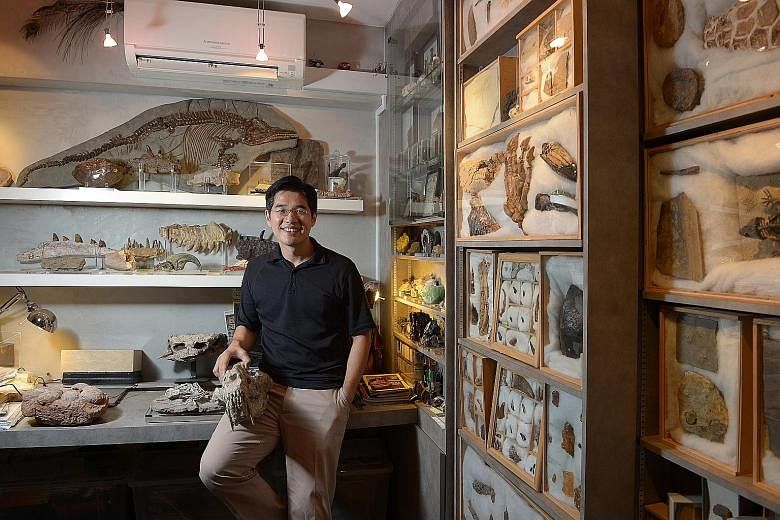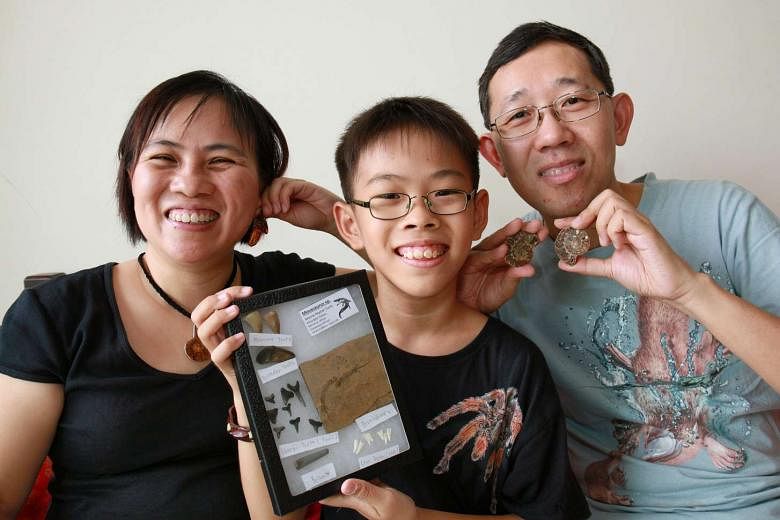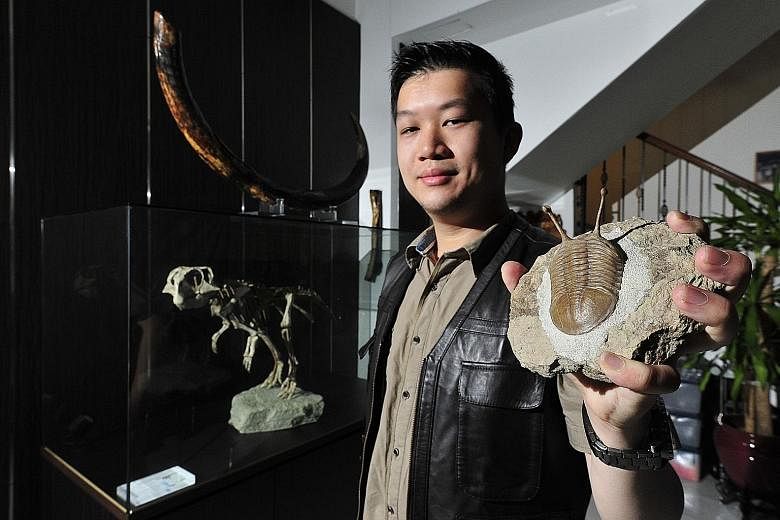Three exhibits take pride of place in Mr Tan Han Yang's living room. The first is a complete skeleton of a psittacosaurus dinosaur housed in a glass vitrine, its delicate white bones standing out against the room's dark panels.
Wilson, as this specimen is called, lived about 120 million years ago and is the size of a large cat.
Above it sits an elegant curved sculpture with a burnt texture. You could mistake it for art, but it is actually the 1.75m-long tusk of a woolly mammoth.
On the ground, a thick, gnarled trunk rises up to waist-level so you can place your elbow on its stump. This is the 50kg femur bone of the edmontosaurus, a duck-billed, plant-eating dinosaur.
There is more upstairs in his semi-detached house in Sembawang. In Mr Tan's bedroom, floor-to-ceiling glass displays contain dinosaur eggs, teeth of prehistoric sharks and fossils of trilobites, which are hard-shelled prehistoric critters.
-
How to get started on fossil collecting:
-
• Start by picking a type of specimen to collect before branching out to others.
• There are only a handful of shops selling fossils in Singapore, so it is better to go online.
Reputable websites include: extinctions.com; www.bigfossil.com; fossilshk.com; www.fossils-uk.com; henskensfossils.nl; www.ha.com; and www.catawiki.com
• Try eBay too, under the collectibles category of "rocks, fossils & minerals". Try to be as specific as possible by using keywords and filter the price to match your budget. Look out for sellers with higher reputation scores and avoid vertebrate fossils from China as they are likely to be fake.
• Read up to get a sense of how much certain fossils should cost so you will not be duped into purchasing a fake one at a low price.
• Join the Singapore Fossil Collectors Facebook group (www.facebook.com/groups/ fossilcollector) and learn from the regulars.
Also attend its quarterly meet-ups where you can buy or trade fossils.
• Make friends with enthusiasts in other parts of the world too. The Fossil Forum (www.thefossil forum.com) is a good place to start.
• There are other Facebook groups such as The Boneyard Trading Post and Fossil Collection Classified to trade with in a safe and regulated environment.
•Tips from Mr Tan Han Yang and Mr Calvin Chu. Go to their website fossilcollector.wordpress.com to learn more.
Mr Tan, 24, who has just graduated from the Singapore Institute of Management with a degree in creative computing, has been collecting fossils since he was eight. Currently, he is exploring career options related to his passion.
He lives with his parents and older sister, and has spent a low six- figure sum on his collection.
With more than 1,000 fossils to his name, he is part of a niche group of paleontology enthusiasts in Singapore passionate about collecting the remnants of former geologic periods.
He says: "It is simply so empowering holding a 500 million-year-old fossil in your hands and imagining what life was like and how it has come to be."
He is also the co-administrator of Singapore Fossil Collectors, a public Facebook group with more than 400 members who share information, swop photos of their recent purchases and plan quarterly meetups to marvel at one another's collections and trade fossils.
The group was started four years ago by strategy consultant Calvin Chu, 38, when a Life feature on his fossil collection - which is one of the largest in Singapore at more than 1,000 artefacts - led to fellow enthusiasts reaching out to him.
That gave him an idea to create an online space where they could exchange pictures and information.
Highlights of his collection include a 0.61m-long skeleton of a dromaeosaur raptor - a fast- running, bird-like predator - lying serenely on a rock in a sleeping pose, as well as a sabre-tooth tiger skull.
Mr Chu loaned the skull to the Science Centre Singapore for a dinosaur and ice age mammals exhibition in late 2013.
In his five-room Tanjong Pagar HDB flat, his treasures are tucked away - Hollywood spy movie-style - in a secret study behind three heavy bookcases.
This is because his wife, who is a business intelligence analyst, preferred the house "not to be decorated with bones".
They have a son aged three and a five-month-old daughter. Like Mr Tan, Mr Chu has spent a low six- figure sum on his collection.
The fascination with fossils for the two men started with the trilobite - a small sea creature that lived on earth in the Cambrian period, which dates back to more than 500 million years ago, even before dinosaurs existed. The trilobite's closest living relative is the horse-shoe crab.
Trilobites are an especially significant part of Mr Tan's collection. He has at least 50 different species, which range in size from under 1cm to 30cm.
He adds: "It is mind-blowing how such bizarre-looking creatures existed before the time of the dinosaurs. They are also considered extremely successful, having lasted more than 300 million years."
Most fossil collectors go on to collect other specimens such as minerals and asteroids.
Mr Chu, who has bottles of different kinds of sand as well as a shelf filled with different minerals and meteorites, says: "Once you start with one species, it inspires you to find out about what else roamed the earth before or after."
The collectors source for fossils on online marketplaces such as eBay and Catawiki, fossil forums such as The Fossil Forum, or while on trips to countries where fossils are more readily available. These places include the United States, Britain and Australia.
In Singapore, only a handful of stores here sells fossils, including a small section in the Books Kinokuniya outlet in Ngee Ann City. More common are mineral and antique shops which sell a tiny selection of fossils at high prices.
Mr Chu says: "In the last 10 years or so, I have seen shops that sell fossils close down after a short while.
"In Singapore, the market is tiny and the sellers don't invest in drumming up demand and interest in fossils. Rather, they just mark up prices to cover rental and manpower costs."
In fact, the high cost of fossil collecting is one of the biggest misconceptions that Mr Tan and Mr Chu hope to change with the creation of their Facebook group.
Mr Tan says: "You can easily get a common trilobite online for less than $10 so it is actually an affordable hobby."
To make fossils more accessible to the public, the two run an online fossil marketplace and have conducted at least 20 educational talks since 2012.
Mr Chu says: "We see ourselves as Singapore's travelling paleontology museum, visiting and speaking at many schools and public forums to spread the awareness and love of natural history."
They have spoken at institutions such as United World College of South East Asia, National Junior College, as well as at the ArtScience Museum and Science Centre Singapore, where dinosaur or fossil- themed exhibitions were held.
At United World College, they brought along fossils to teach the students about the different geological periods and the types of fossils and how they are formed.
Mr Scott Ziemer, head of Grade 4 at the school, says: "Rather than look at fossils in textbooks, holding a dinosaur or megalodon tooth in your hand makes for a vivid and lasting learning experience."
At the ArtScience Museum last year, the duo met the Sohs, a fossilloving family of three: Senior software developer Soh Kam Ying, 47, civil servant Ho Li Yah, 43, and their son Zhi Bing, nine.
Since the age of four, Zhi Bing has shown an avid interest in dinosaurs. Now his love of all things prehistoric can be seen in the way he rattles off fossil facts.
He adds: "Fossils are interesting as they give us a peek into the past and we can learn how life was like millions of years ago."
His mother, too, has been fascinated by dinosaurs and ambers since she was a teenager.
She says: "I used to tell my parents that if I weren't born in Singapore, I would have become a paleontologist."
There are currently no paleontologists in Singapore.
However, the recent opening of the Lee Kong Chian Natural History Museum and an increase in the number of dinosaur-themed exhibitions held over the years could draw more fossil enthusiasts.
Meanwhile, Mr Chu and Mr Tan will continue to spread the love.
For Mr Chu, it is all about seeing that moment of wonder when a person touches a fossil for the first time."The fascination it creates will ignite a lifetime of curiosity."
Mr Tan, on the other hand, hopes to set up a private museum one day focusing on fossils and paleontology.
He says: "Every fossil has an interesting story behind it and I find joy in sharing it with people. It's even better if I can encourage them to start their own collections."



